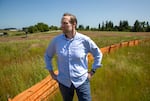
Clark County Commissioner Sue Marshall in a field of hazelnuts on her farm outside of Ridgefield, Wash., on June 10, 2025.
Erik Neumann / OPB
Sue Marshall likes to brag about the pears, apples and garlic that she’s won blue ribbons for at the Clark County Fair. But more than anything else, she’s proud of the hazelnuts that she and her husband grow on their 29-acre farm.
Last year they harvested 18,000 pounds. This year, she says, they hope to double that.
Their farm sits on the outskirts of Ridgefield, the rapidly growing city a half hour north of Vancouver with a deep farming history. In the past, the area included several dairies, as well as potato, hazelnut and prune operations.
“It was a big deal,” Marshall said, puttering along on an orange and black Kubota farm cart. “They had a festival, there was a prune queen, there was a collection of ‘Prunarians,’ similar to the ‘Rosarians’ for the (Portland) Rose Festival.”
Besides running the small farm, Marshall is the chair of the Clark County Board of Commissioners. At the moment, she’s helping oversee the county’s next comprehensive plan, a laborious planning process required under Washington state’s Growth Management Act.
The official goal of the plan is to guide the next 20 years of population and employment in the county by developing regulations for future growth. For small farmers like her, there’s an existential urgency to the plan in a region where farmland has steadily given way to housing developments.
The comprehensive plan is wonky, but important. County leaders use it to decide where to place homes, farms and a dozen other competing priorities — and to decide which ones are most critical.
“How do you protect wildlife? How do you protect water quality?” Marshall said. “Just looking at it in economic terms, those kinds of things have been externalized.”
Highest and best use
Few people are as familiar with the changes around Ridgefield as Dennis Zimmerly.
Zimmerly is a fourth-generation Ridgefield resident. His family came to the area in 1881 and operated a large potato farm in the area, which they referred to as “spuds,” he said. He recalls a time when students and faculty at the new Ridgefield High School were debating a school mascot.
“They liked the name of spuds and decided to call them ‘spudders,’” he said.
The alternative, given the region’s flora?
“The prunes.”
These days, Zimmerly manages a development company, and he has little nostalgia for the dairy and potato farms of his youth. His company, Z20, is hoping to develop 200 acres, currently zoned farmland, on the north edge of Ridgefield for a large housing development. If it happens, the development will include nearly 1,000 units priced at 80% of the median income, as well as 200 senior care units.

A subdivision on the edge of Ridgefield's current urban growth boundary. The neighboring field could be developed if the city is allowed to expand it's urban growth boundary as part of the Clark County comprehensive plan update.
Erik Neumann / OPB
The project would be a small step toward addressing the region’s unmet housing need. According to the Washington State Department of Commerce, the state suffers from a critical lack of affordable housing, which the agency pegs at 50% of the area median income. Meanwhile, Clark County’s largest city, Vancouver, is on track to build fewer than half the number of housing units needed in 2025 for reasons including tariff uncertainty, inflation and high construction costs.
The plan to expand the city’s boundary to absorb the farmland Zimmerly manages, rather than add density within existing city limits, has caused consternation for environmental groups; they say it’s just the latest example of the steady march of development into irreplaceable agricultural land. But Zimmerly argues agriculture should be displaced to accommodate housing and businesses so that Ridgefield residents don’t need to constantly commute to Vancouver.
“It’s now getting the services that can sustain a community,” he said. “To me, it would only make sense to continue to provide housing because the services are here.”
Runaway growth
The Zimmerly development would be the latest expansion of Ridgefield’s urban growth boundary. Before the pandemic, it was ranked the fastest-growing city in Washington state. From 2020 to 2024, Ridgefield’s population shot up by 48%, according to the U.S. Census. Nearby Vancouver crept up by just 4.2% during the same period.

Ridgefield Mayor Matt Cole stands in a 200-acre property proposed for development as part of the Clark County comprehensive plan updated on June 3, 2025.
Erik Neumann / OPB
Ridgefield is attractive because it remains semi-rural with less urban density than Vancouver, but still offers easy access to amenities, according to Mayor Matt Cole.
“There’s this idea of adding more density. And for bigger metropolitan areas, I think that makes total sense,” he said. “But you have to build a community that fits the identity and vision of what you have.”
Fewer of the large, single-family homes are being built in Ridgefield, Cole said, but in the meantime, there’s still plenty of demand.
“You can see Mount St. Helens on a good day. This is why people live here. It’s beautiful,” he said. “But they’re still moving here. So, we’ve got to accommodate them.”
Continued growth worries others, who have seen the region’s ag land slowly consumed by development. The nonprofit Friends of Clark County advocates for what its members call “responsible growth.” The organization was created in the early days of the state’s Growth Management Act to focus on the unincorporated areas of the county threatened by development. The nonprofit argues that the proposed housing developments in the comp plan would be better done as multi-family infill within city limits, rather than spilling out into farmland.
“Once you take it away, people aren’t going to be interested in living here. We’re going to be Bakersfield, California, and people want to move out of there,” said Ann Foster, the board president of Friends of Clark County.
And they have a point. According to the county’s Vacant Buildable Land Model, the growth planned in Clark County until 2045 could occur within nearly all local cities, without building on farmland. However, county planners point out, current zoning for single-family homes makes it hard to build enough low-income housing inside city limits. First they’d need to rezone to allow for more duplexes and triplexes or higher density multi-family developments.
“We believe that things have to be dealt with more creatively if we’re going to preserve our rural areas and our farm areas,” said David McDonald, an attorney with Friends of Clark County. “We’re looking for that 40-year vision.”

A single-family home being built in a development in Ridgefield, Wash., near the city's urban growth boundary on June 9, 2025.
Erik Neumann / OPB
Twenty years before Washington’s Growth Management Act, Oregon passed its own land use planning law. Signed by then-Gov. Tom McCall in 1973, SB 100 created the Land Conservation and Development Commission which requires development to stay inside defined urban growth boundaries to protect ag land and open space. The legislation protected Oregon’s rural feel but had side effects in neighboring Washington state, according to Marshall.
“A lot of those people that wanted an acre or a few acres to build a McMansion or have an expansive lawn, they looked to Clark County,” she said.
Related: Inside the fight between Oregon leaders to create a revolutionary growth management system
A 2012 report from the Sightline Institute showed that even after both states had growth management policies in place, rural and exurban housing grew by 18% in Clark County from 2000-2010. In Clackamas, Multnomah and Washington counties, it grew by just 4-5% which the report attributes to more established growth management rules in Oregon.
There are a number of markers in the coming months as the county moves toward its Dec. 31, 2025, deadline for the plan. In August, a draft environmental impact statement will be published. All the while, county officials will try to balance a host of competing priorities from promoting economic development and avoiding sprawl, to building housing and protecting agricultural land.

Clark County Commissioner Sue Marshall driving around her 29-acre farm outside of Ridgefield, Wash., on June 10, 2025.
Erik Neumann / OPB
On the edge of her property, Marshall shifted the Kubota into park and looked across at a neighboring u-pick strawberry farm and 60 acres of fields beyond that. Before the comp plan was in place, she said, the owners kicked off the farmer who was leasing it. Soon it’ll be developed into a dozen five-acre parcels.
“It’s a little deceptive when you look across the landscape because it looks like, ‘Oh, look at all this agricultural land,’” she said. “But a lot of it has already been subdivided. That parcel-ization can kind of be the death knell of successful agriculture.”
